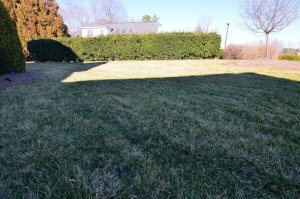Winter lawn care can be a battle. Here’s what you may encounter and what can help, for either a warm season or a cold-season lawn.
North Carolina is known for its ever-changing weather, and January and February typically bring some of the coldest temperatures we see in the area all year. In times like these, wanting to keep your lawn vibrant through the cold can feel like an uphill battle. It’s crucial to understand how lawns are affected by cold weather, and what can be done to help them, to make it a manageable winter.
The term “cool season” is a little bit of a misdirect. Cool-season lawns — like fescue, blue grass and rye grass — aren’t set up for success in harsh winter conditions. More accurately, cool-season grasses perform best in milder temperatures of spring and fall (they’ll actually grow best in a temperature range of 60-80°).
Warm-season turfgrasses — from zoysia and bermuda grass, to centipede and St. Augustine — typically go dormant during the cooler months. During this time, less water is needed and incorrect fertilizer will be ineffective. Correct fertilizer will help keep the roots healthy so the grass can grow back in the spring. However, this can mean that the grass itself is more susceptible to damage now, albeit temporarily in most cases. In addition to treating specific issues, it’s important to invest in a comprehensive plan to make sure warm-season lawns remain healthy to bounce back in the spring.
As in most cases when it comes to lawns, preemptive measures will set you up for the best success. For cold weather, actions you take in the fall and early-winter can have long-term benefits. Even with the best-laid plans, though, you may still experience some setbacks.
Here are some of the issues you may encounter, and what exactly can be done about them.
Colors changes can show up in a few different ways. Often with fescue-grass variants, a light-green color can mean the turf is not actively growing or has received desiccation or frost injury, which can be expected during the winter.

If you didn’t get the right fertilizer application for your lawn in the previous months, this could also be the culprit. But don’t worry: an application in the spring, tailored to your lawn’s particular needs, can likely bring it back to normal.
All warm season turf will go dormant/semi-dormant during the winter. As spring arrives, and temperatures become more favorable for growth, turf will start to green up in different stages.
A turf colorant can help by providing a green appearance during the winter months.
Winter annual and perennial weeds can be problematic this time of year. Post-emergent broadleaf weed controls can be applied to help manage broadleaf weed populations.
The most prolific broadleaf weeds are chickweed, bittercress, and henbit this time of year. Annual bluegrass is the dominant grassy weed in lawns this time of year.

In general, prevention is the best step when it comes to weeds. The more healthy and dense a lawn is, the more likely it is to prevent weeds in the first place. Mowing fescue at 3.5 – 4.0”, routine watering, professional fertilization and more will go a long way towards this. It’s best to deal with them now — head-on with control tools — before they’re done growing in late winter, start to reproduce in spring and become difficult to manage.
For any type of lawn, the best offense against winter woes is always a good defense. Getting ahead of potential cold weather issues in the fall and early-winter can go a long way, but it’s never too late to bring in the experts.
Find out how Fairway Green can help meet your lawn’s needs, for now and the future, by requesting your free lawn quote today!